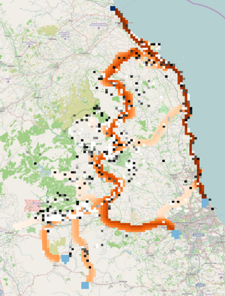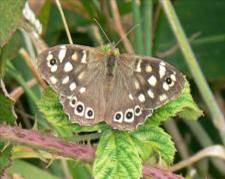
Dr Jenny Hodgson PhD
Reader / UKRI Future Leaders Fellow Evolution, Ecology & Behaviour
- +44 (0)151 795 4513
- Work email Jenny.Hodgson@liverpool.ac.uk
- Personal WebsiteWebsite of the Condatis project for planning habitat networks
- About
- Research
- Publications
- Teaching
- Professional Activities
Research
Planning the restoration of habitat networks

Nature conservation organisations are increasingly planning to restore degraded habitats. Restoration could help with two crucial interrelated challenges in the 21st century: conserving species in a changing climate and conserving ecosystem functioning at large spatial scales. Habitat loss and fragmentation make species especially vulnerable to climate change, both because their populations are smaller, and because the gaps between suitable areas are more difficult to cross. This could prevent species from shifting their geographic ranges to ‘track’ the changing climate. However, restoration is expensive and there are many competing demands on land, so it is particularly important to develop methods of selecting the most beneficial restoration locations.
My research has shown that strongly aggregated patterns of habitat - which are traditionally recommended in conservation to prevent extinctions - can leave large gaps which inhibit range shifting. However, other patterns facilitated range shifting of simulated species, and the rate of shift could be predicted by a straightforward metric: conductance. Conductance is based on circuit theory, and further work exploits properties of the circuit in order to pinpoint the best places in the landscape to add habitat, or the least costly places to lose habitat. This theory has been translated into the software Condatis for mapping and prioritising habitat networks. I worked in partnership with seven major UK conservation organisations to design the first version according to their analysis priorities and data availability. In January 2016, NERC knowledge exchange fellow Katherine Allen started to work with the Condatis project, enabling effective communication with a much broader range of stakeholders. For further information see the project website condatis.org.uk.
Condatis can also be used as a research tool, and I am continuing to develop the theory behind it. My PhD student Tom Travers is improving the ways that Condatis can be used in different kinds of decision-making scenarios, in collaboration with Natural England. Recently Sarah Scriven (with Jane Hill, University of York) has used Condatis and my simulation model to examine the isolation of lowland protected areas in Borneo, and the conditions needed for species to reach equivalent climate at higher elevations as the climate warms. Sarah has also analysed how ‘high conservation value’ forest patches in oil palm plantations on Borneo might contribute to large-scale connectivity. In 2017-19, I used my modelling techniques in a Newton Fund project (project blog), led by Jane Hill, to develop recommendations for forest restoration on peatland in Indonesia.
Conservation in agricultural landscapes

Many species in human dominated landscapes such as the UK experience mosaics of seminatural habitat and agricultural habitats. The quality of these habitats and the spatial interactions between them will determine species’ persistence. However, policies and funding streams for managing semi-natural and agricultural habitats are not sufficiently integrated. In 2010, I published one of the first studies directly comparing the biodiversity values of seminatural habitats and wildlife-friendly farming, and quantifying the so-called land-sparing/land-sharing trade-off. Recently my PhD student Jamie Alison (Jamie's webpage), in partnership with Natural England, has looked in more detail at two different types of agri-environment schemes (AES). He has elucidated moth community responses to generic AES and more targeted whole-field restoration options, contingent on connectivity to seminatural habitat. I am also co-supervising Katie Threadgill, a PhD student at the University of York, in partnership with FERA, looking at how butterfly populations respond to amounts of AES and semi-natural habitat in the surrounding landscape.
Understanding contemporary range shifts

There is abundant evidence that species are already shifting their geographic ranges in the directions expected from climate change trends, and some of the best evidence comes from UK invertebrates. However, it is still a challenge to understand why some species shift more than others, whether habitat fragmentation is holding species back, and what conservationists could do to help. The Silver-spotted Skipper butterfly, which I have studied since 2011, is an exemplar species where we understand how populations respond to temperature, and how habitat structure and dispersal determine where populations persist at larger scales. For this species, we can explain its range expansion since the 1980s with metapopulation models – it has expanded to colonise hundreds of new patches even though it is restricted to seminatural calcareous grassland. We have also shown how especially hot (south-facing) patches and especially hot years have helped the expansion, and how actively-managed patches are more likely to be colonised. Another warmth-loving butterfly, the Grizzled Skipper, is by contrast failing to expand its range. My current PhD student Fiona Bell is investigating what may be constraining Grizzled Skipper populations, in collaboration with the charity Butterfly Conservation.
I am broadening these studies to use population genomic data to infer the history of population colonisations for species where we don’t have exhaustive population surveys (as we do for the Silver-spotted Skipper). My PhD student Georgina Halford will be using genomic and remotely sensed data to understand population dynamics of the Chequered Skipper butterfly, which is the focus of an ambitious re-intoroduction project by Butterfly Conservation. I am also collaborating with Ilik Saccheri, Jane Hill and PhD student Eve Taylor-Cox to understand range shifts of the moth Lymantria monacha and the butterfly Pararge aegeria and quantify the impacts of habitat fragmentation and dispersal ability.
Research Grants
Discipline Hopping for Environmental Solutions
NATURAL ENVIRONMENT RESEARCH COUNCIL
January 2022 - March 2022
Enhancing the benefits of tropical peatland restoration for supporting local communities and ecosystem processes.
NATURAL ENVIRONMENT RESEARCH COUNCIL
August 2017 - November 2019
URBAN GreenUP - New Strategy for Re-Naturing Cities through Nature-Based Solutions
EUROPEAN COMMISSION
June 2017 - May 2023
Decision support for restoring ecological networks in rapidly developing, biodiverse countries
NATURAL ENVIRONMENT RESEARCH COUNCIL
November 2017 - April 2019
Landscape scale synergies between agri-environment schemes and protected sites
NATURAL ENGLAND (UK)
October 2013 - September 2016
Facilitating population spread in a patchy landscape
NATURAL ENVIRONMENT RESEARCH COUNCIL
June 2013 - August 2013
Achieving bigger, better and more joined-up habitat networks: quantifying benefits and comparing scenarios
NATURAL ENVIRONMENT RESEARCH COUNCIL
January 2014 - April 2015
New methods to plan landscape-scale conservation
NATURAL ENGLAND (UK)
March 2013